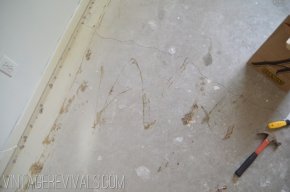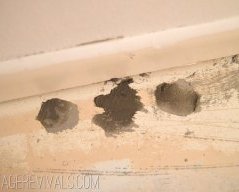
 Happy Monday my friends! You may or may not know that about a year and 1/2 ago I posted a really through tutorial for painting concrete/cement. Ivie’s floor was my first experience and its held up really well, so well in fact, that I decided to rip the carpet out of Dylan’s room and paint her floor too.
Happy Monday my friends! You may or may not know that about a year and 1/2 ago I posted a really through tutorial for painting concrete/cement. Ivie’s floor was my first experience and its held up really well, so well in fact, that I decided to rip the carpet out of Dylan’s room and paint her floor too.
So why another tutorial? Well, I’ve learned a few things along the way that I would love for you to know to (in case you are planning on tackling your own concrete painting project!)
Carpet Removal
First up is carpet removal. Not the funnest job in the world, that is for sure. Dyl’s room is preeeeetty small so it wasn’t a horribly hard job (but if you need a few more tips on that, pop over and check out this post on YHL.)
Once your carpet and pad are out its time to remove the tack strips. (Those are the pieces of wood along the edge of your carpet that hold it in place.) You can use a myriad of tools for this from a chisel, to a hammer, to a screw driver. We used floor scrapers to remove them (you can see both of them in the picture above) The one on the left is a little finer and you have a little more control, and the one on the right is sort of like the bulldozer of floor scrapers and destroys everything in its path. Basically you are using them to pry up the tack strips. Make sure when you pick them up you are wearing gloves, those suckers are sharp.
 Remove Adhesive
Remove Adhesive
Now you have the fun job of getting off all of the carpet glue. And actually the proper spelling of that would be Carpet Human Fly Trap GAAA-LOOOOOOE. Our carpet was laid when we moved into our house 4 years ago and the glue was still VERY sticky. I don’t know at what point it looses its tack and becomes concrete like but I have heard that does happen….
In my first post I talked about dousing it with Lacquer Thinner and letting it sit and then dousing it again and scraping it off with a plastic scraper. This is what I have learned since then, if you pour a fair amount of Lacquer Thinner on and then cover it with a plastic garbage bag for 10 minutes the glue comes RIGHT off. Very little scraping involved. I took a few garbage bags and cut them down one side and the bottom so that they could cover a larger area.
Fill Holes
 If you previously had carpet, then you are going to have lots of cute little holes along your baseboard that will need to be filled before you can paint. Mix up a batch of Quickcrete and fill your holes (its ok if you overfill them a little) and let it cure overnight.
If you previously had carpet, then you are going to have lots of cute little holes along your baseboard that will need to be filled before you can paint. Mix up a batch of Quickcrete and fill your holes (its ok if you overfill them a little) and let it cure overnight.
Sand Baby Sand
The last prep step is to sand your heart out. Use a pole sander (you can buy them for around .00 at Sherwin Williams) and 80 Grit Sand Paper to rough up the entire surface of the floor. Sand the entire floor one direction, then sweep it up. Then sand it in the opposite direction, then sweep it up. Then sand one MORE time and this time when you sweep you want to sweep, vacuum, sweep, vacuum. Until you are SURE there is no dust left. (If you get it wet at this point you will have to wait 24 hours for it to fully dry, so don’t do that) Just sweep and vacuum like your floor’s life depends on it…because it does. Take special care to sand along the edges where you filled the tack strip holes and they should blend right in.
Now comes the fun part.
Paint
Painting a floor is hands down the easiest thing on the planet. In fact I would rather paint 5000 floors than 1 ceiling. You don’t even need a paint tray!
But you do need good paint. Regular latex paint is NOT for this project. You need something specially designed to withstand the beatings that a floor takes. The paint that I recommend is Sherwin Williams Porch and Floor Enamel. It is AMAZING and has held up SO well in Ivie’s room. It is a water based paint (so no crazy fumes) that is self priming and goes on so smooth. You do not want to get the wrong product when you are doing a project like this (can you imagine?!). You can have it tinted to any color of the rainbow, but personally I love the Extra White Base.













